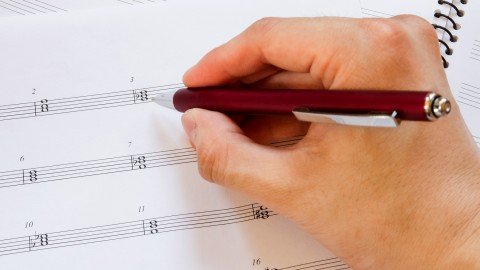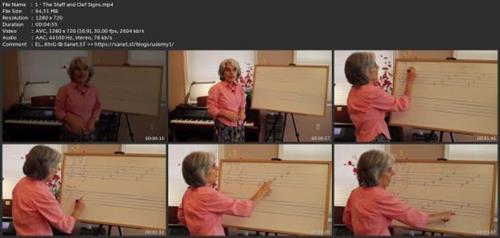- Thread Starter
- #1
Beginning Music Theory - Hands-On Approach

Learn how to speak and understand the language of music with this systematic and hands on approach of music theory.
What you'll learn
By the end of the course, the student should be able to write, read and play simple melodies and understand basic rhythm principles.
Requirements
Computer, printer, piano (optional).
Description
Have you ever wanted to understand the jargon of music? Or have you wished to understand the music that you are playing in the deeper and more meaningful way?
This beginning music theory course, built to provide step by step information in a logical and systematical way, will help you do just that. Unlike many others, this is hands-on course that will cover the following topics:
The Staff & Clef Signs Note Values & Their Rests The Measure & Time Signatures Ledger Lines Repeat Signs & 1st and 2nd Endings The Tie & the Slur Flats, Sharps & Accidentals
The course is divided in 11 short videos, each lesson being accompanied by an outline and a worksheet. An answer worksheet is also provided. By the time you print all the documents, you will have a nice booklet with all the information that you can always refer back to and hands-on assignments that are invaluable since they help solidify the concepts learned in the video. The student should answer the question in the worksheet and check his/her work with the answer sheet. I highly recommend that the student does not skip the assignment sheets.
Music theory is very important for a musician; it gives the student a better understanding of the music he/she performs and it is a structural platform for improvisation, composition, transposition, sight-reading, etc. Music theory is the grammar of the musical language and we need to know it in order to speak the language of music correctly. It helps us understand how music fits together and why it sounds the way it does. For a person desiring to become a musician, music theory is a must.
I am looking forward to help you in any way I can. I have been a professional piano teacher for over 25 years and played the piano in many concerts, recitals, accompanying and conducting choirs over the year. I have written many pieces for choir and small ensemble and orchestrated and recorded many CDs. I will do my outmost to help you understand the topics in this course. Just ask if you need any help!
Enroll today and be on your way of becoming an accomplished musician! Learn music theory online! Thank you for taking my course.
Overview
Section 1: Beginning Music Theory
Lecture 1 The Staff and Clef Signs
Lecture 2 Music Notation and Note Values
Lecture 3 The Measure and Time Signatures
Lecture 4 Note Values and Rest Values
Lecture 5 Dotted Notes and Dotted Rests
Lecture 6 Ledger Lines
Lecture 7 Repeat Signs & 1st and 2nd Endings
Lecture 8 The Tie and Slur
Lecture 9 Eight Notes and Eight Rests
Lecture 10 Dotted Quarter Notes
Lecture 11 Flats, Sharps, Natural Signs and Accidentals
Lecture 12 Conclusion
This course is designed for 12 year old students and up. Keep in mind that this is a beginning course, for those that do not have any knowledge of music theory, but it is helpful if the student has a piano and a recognition of the name of the piano keys. Reading, writing and basic math abilities are crucial.,Teachers also are encouraged to use this course in their music instruction. Homework and outlines are already planned and available for download.

rapidgator.net:
ddownload.com:

Last updated 9/2015
MP4 | Video: h264, 1280x720 | Audio: AAC, 44.1 KHz
Language: English | Size: 1.00 GB | Duration: 0h 55m
MP4 | Video: h264, 1280x720 | Audio: AAC, 44.1 KHz
Language: English | Size: 1.00 GB | Duration: 0h 55m
Learn how to speak and understand the language of music with this systematic and hands on approach of music theory.
What you'll learn
By the end of the course, the student should be able to write, read and play simple melodies and understand basic rhythm principles.
Requirements
Computer, printer, piano (optional).
Description
Have you ever wanted to understand the jargon of music? Or have you wished to understand the music that you are playing in the deeper and more meaningful way?
This beginning music theory course, built to provide step by step information in a logical and systematical way, will help you do just that. Unlike many others, this is hands-on course that will cover the following topics:
The Staff & Clef Signs Note Values & Their Rests The Measure & Time Signatures Ledger Lines Repeat Signs & 1st and 2nd Endings The Tie & the Slur Flats, Sharps & Accidentals
The course is divided in 11 short videos, each lesson being accompanied by an outline and a worksheet. An answer worksheet is also provided. By the time you print all the documents, you will have a nice booklet with all the information that you can always refer back to and hands-on assignments that are invaluable since they help solidify the concepts learned in the video. The student should answer the question in the worksheet and check his/her work with the answer sheet. I highly recommend that the student does not skip the assignment sheets.
Music theory is very important for a musician; it gives the student a better understanding of the music he/she performs and it is a structural platform for improvisation, composition, transposition, sight-reading, etc. Music theory is the grammar of the musical language and we need to know it in order to speak the language of music correctly. It helps us understand how music fits together and why it sounds the way it does. For a person desiring to become a musician, music theory is a must.
I am looking forward to help you in any way I can. I have been a professional piano teacher for over 25 years and played the piano in many concerts, recitals, accompanying and conducting choirs over the year. I have written many pieces for choir and small ensemble and orchestrated and recorded many CDs. I will do my outmost to help you understand the topics in this course. Just ask if you need any help!
Enroll today and be on your way of becoming an accomplished musician! Learn music theory online! Thank you for taking my course.
Overview
Section 1: Beginning Music Theory
Lecture 1 The Staff and Clef Signs
Lecture 2 Music Notation and Note Values
Lecture 3 The Measure and Time Signatures
Lecture 4 Note Values and Rest Values
Lecture 5 Dotted Notes and Dotted Rests
Lecture 6 Ledger Lines
Lecture 7 Repeat Signs & 1st and 2nd Endings
Lecture 8 The Tie and Slur
Lecture 9 Eight Notes and Eight Rests
Lecture 10 Dotted Quarter Notes
Lecture 11 Flats, Sharps, Natural Signs and Accidentals
Lecture 12 Conclusion
This course is designed for 12 year old students and up. Keep in mind that this is a beginning course, for those that do not have any knowledge of music theory, but it is helpful if the student has a piano and a recognition of the name of the piano keys. Reading, writing and basic math abilities are crucial.,Teachers also are encouraged to use this course in their music instruction. Homework and outlines are already planned and available for download.
Screenshots

rapidgator.net:
You must reply in thread to view hidden text.
ddownload.com:
You must reply in thread to view hidden text.
